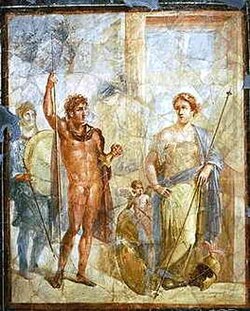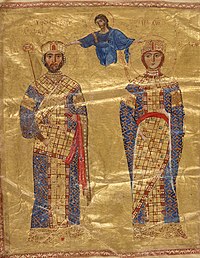Transcontinental royal intermarriage
 From Wikipedia - Reading time: 6 min
From Wikipedia - Reading time: 6 min

This article's aim is to gather examples of transcontinental royal intermarriages, that is, royal intermarriage between royal families originating from different continents. One of the best-known instances of transcontinental royal intermarriage is the one between Alexander the Great, king of Macedon, and his three Persian wives, Roxana, Stateira and Parysatis.
Ancient Macedonia
[edit]Alexander the Great and the Susa weddings
[edit]in 327 BC, during his conquest of the Achaemenid Empire, Alexander the Great fell in love with Roxana, daughter of the Bactrian nobleman Oxyartes, and married her despite his companions' opposition. Roxana will later give birth to a son after Alexander's death, Alexander IV of Macedon.[1][2]
After Alexander defeated Darius III at the Battle of Issus, he captured his family, including his daughter Stateira. In 324 BC, during a mass wedding known as the Susa weddings, Alexander married both Stateira and her cousin Parysatis, members of the Achaemenid dynasty. Other notable marriages that occurred during the Susa weddings are the one between Selecus I and the Sogdian noble Apama and the one between Ptolemy I and the Persian noble Artakama[3][4][5]
Byzantine Empire
[edit]Khazarian dynasties
[edit]In 695, the Byzantine emperor Justinian II was deposed and exiled to Crimea. In 703, he escaped and received help by Busir, khagan of Khazaria, who offered him his sister's hand. Justinian accepted and renamed her Theodora, probably after the wife of Justinian I. The couple had one son, co-emperor Tiberius IV.[6][7][8]
Around 732, to solidify an alliance with Khazaria, the future emperor Constantine V married Tzitzak, daughter of khagan Bihar. Tzitzak was later renamed "Irene". The marriage produced Byzantine emperor Leo IV, who was given the epithet "the Khazar" referencing his maternal descent.[7][9]
Armenia and Georgia
[edit]
Due to the closeness of the empire with the two realms, Byzantine royals often married with Armenian and Georgian dynasties. Here follows a list of documented marriages:
- Emperor Michael VII and Maria of Alania.[10]
- Emperor Nikephoros III and Maria of Alania.[10]
- Hovhannes-Smbat III of Armenia and an Argyra (niece of emperor Romanos III)[citation needed]
- Constantine I of Armenia and Pokhaina (relative of emperor Nikephoros II Phokas)[11]
- Theodore I of Nicaea and Philippa of Armenia.[12]
- David VI of Georgia and Theodora Doukaina Palaeologina (daughter of emperor Michael VIII).[13]
- Emperor Michael IX and Rita of Armenia.[14]
- Demetrius II of Georgia and Megale Komnena (daughter of Manuel I of Trebizond).[citation needed]
- Bagrat V of Georgia and Helene of Trebizond.[15]
- Bagrat V of Georgia and Anna of Trebizond.[15]
Mongol khanates
[edit]Around 1265, Byzantine Emperor Michael VIII attempted to start diplomatic relationships with the Mongol Ilkhanate. A marriage was combined between Ilkhan Hulagu, and Michael's illegitimate daughter, Maria Palaiologina. Maria left Costantinople in 1265, but when she arrived in Caesarea she was informed that Hulagu had died, so it was decided for her to marry Hulagu's son, Abaqa. The Mongols called Maria "Despina Khatun". The marriage produced a daughter, Theodora Ara Qutlugh.[16][17][18][19]
Michael VIII also tried to form an alliance with the Golden Horde. In 1266, he gave another illegitimate daughter, Epuhrosyne Palaiologina, in marriage to the khan Nogai. There are no known children resulting from this marriage.[20]
England
[edit]Failed alliance with the Ayyubids
[edit]In a negotiation between Richard the Lionheart and Saladin during the third crusade, it was proposed to arrange a marriage between al-Adil, Saladin's brother, and either Richard's sister Joan or his niece Eleanor. The arrangement however failed for religious reasons.[21]
Hungary
[edit]Cumania
[edit]Around 1238, Béla IV of Hungary arranged a marriage between his son, future Stephen V, and Elizabeth, the daughter of a Cuman leader whom he had invited to settle in the plains along the river Tisza. This leader is either khan Köten or a man named Seyhan. The marriage resulted in 4 daughters and 2 sons, among whom there is Laudislaus IV, who succeeded his father, and who was nicknamed "the Cuman" for his mother's origins.[22][23][24][25]
Russia
[edit]Mongol khanates
[edit]In 1315, Yury, prince of Moscow, sealed an alliance with khan Uzbeg of the Golden Horde by marrying his sister Konchaka. Konchaka then converted to orthodoxy and was renamed "Agafiia". She was imprisoned in a war to take the principality of Vladimir and died before she could give Yury any sons.[26][27]
References
[edit]- ^ Foundation, Encyclopaedia Iranica. "Welcome to Encyclopaedia Iranica". iranicaonline.org. Retrieved 2023-12-03.
- ^ Bosworth, A. B. (1981). "A Missing Year in the History of Alexander the Great". The Journal of Hellenic Studies. 101: 17–39. doi:10.2307/629841. ISSN 0075-4269. JSTOR 629841. S2CID 161365503.
- ^ Carney, Elizabeth Donnelly (2000). Women and Monarchy in Macedonia. University of Oklahoma Press. ISBN 978-0-8061-3212-9.
- ^ Ogden, Daniel, ed. (1999-02-01). Polygamy, Prostitutes and Death: The Hellenistic Dynasties. London: The Classical Press of Wales. ISBN 978-0-7156-2930-7.
- ^ "Seleukos Nikator (Routledge Revivals): Constructing a Hellenistic Kingdom". Routledge & CRC Press. Retrieved 2023-12-03.
- ^ Ostrogorski, Georgije (1956). History of the Byzantine State. Blackwell.
- ^ a b Bury, J. B. (2015-03-05). A History of the Later Roman Empire 2 Volume Set: From Arcadius to Irene (Reissue edizione ed.). Cambridge: Cambridge University Press. ISBN 978-1-108-08319-5.
- ^ Norwich, John Julius (1989-03-18). Byzantium (I): The Early Centuries. New York: Knopf. ISBN 978-0-394-53778-8.
- ^ Dagron, Gilbert (2003-11-24). Emperor and Priest: The Imperial Office in Byzantium. Translated by Birrell, Jean. Cambridge: Cambridge University Press. ISBN 978-0-521-80123-2.
- ^ a b Garland, Lynda, ed. (2006-09-01). Byzantine Women: Varieties of Experience 800-1200. Aldershot Burlington (Vt.): Routledge. ISBN 978-0-7546-5737-8.
- ^ Sutton, Joseph A. D.; Dayan, Mireille (1988-01-01). Aleppo Chronicles: The Story of the Unique Sephardeem of the Ancient Near East--In Their Own Words. Thayer-Jacoby. ISBN 978-0-9606472-1-7.
- ^ Angold, Michael (1991), "The Latin Empire of Constantinople, 1204–1261: Marriage Strategies", Identities and Allegiances in the Eastern Mediterranean after 1204, Routledge, pp. 65–86, doi:10.4324/9781315587738-12, ISBN 978-1-315-58773-8, retrieved 2023-12-02
- ^ Rayfield, Donald. Edge of Empires: A History of Georgia. Reaktion Books.
- ^ Byzantium And the Crusades : Harris, Jonathan: Amazon.it: Libri. ASIN 1852855010.
- ^ a b Panaretos, Michael; Bessarion (2019-02-18). Two Works on Trebizond. Translated by Kennedy, Scott. Cambridge (Mass.): Harvard University Press. ISBN 978-0-674-98662-6.
- ^ Runciman, Steven (1987-12-25). A History of the Crusades, Vol. III: The Kingdom of Acre and the Later Crusades. Cambridge: Cambridge University Press. ISBN 978-0-521-34772-3.
- ^ Richard, Jean (1996). Histoire des croisades. Harvard University. [Paris] : Fayard.
- ^ George, Walter S. (2010-07-06). Byzantine Churches in Constantinople - Their History and Architecture. FQ Books.
- ^ Shukurov, Rustam (2016-05-19). The Byzantine Turks, 1204-1461: 105. Leiden: Brill. ISBN 978-90-04-30512-0.
- ^ Nicol, Donald M. (1972). Last Centuries of Byzantium, 1261-1453. London: HarperCollins Distribution Services. ISBN 978-0-246-10559-2.
- ^ Nicolle, David (2005-11-10). The Third Crusade 1191: Richard the Lionheart, Saladin and the struggle for Jerusalem. Christa Hook. Oxford: Osprey Publishing. ISBN 978-1-84176-868-7.
- ^ Berend, Nora (2006-11-02). At the Gate of Christendom: Jews, Muslims and 'Pagans' in Medieval Hungary, c.1000 – c.1300. Cambridge: Cambridge University Press. ISBN 978-0-521-02720-5.
- ^ Engel, Pal (2005-05-25). The Realm of St Stephen: A History of Medieval Hungary. London New York, NY: I.B. Tauris. ISBN 978-1-85043-977-6.
- ^ Tamás, Kőfalvi (1999). "A pécsváradi konvent külső hiteleshelyi tevékenységének főbb jellemzői 1526-ig". Retrieved 2023-12-02.
- ^ Szupernap. "Az Árpád-ház uralkodói · Kristó Gyula – Makk Ferenc · Könyv". Moly (in Hungarian). Retrieved 2023-12-02.
- ^ "Medieval Russia, 980–1584 (2nd ed.)". Retrieved 2023-12-02.
- ^ Halperin, Charles (1987-07-22). Russia and the Golden Horde: The Mongol Impact on Medieval Russian History. Bloomington: Indiana University Press. ISBN 978-0-253-20445-5.
 KSF
KSF